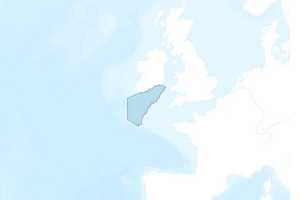Celtic Sea
Planning Site Focus
Reconciling MPAs (30by30), OREs, and fishing spatial allocations via EBSA to protect biodiversity, and satisfice the expectations
The Celtic Sea represents a productive and biodiverse region supporting major fisheries. Fishing effort is relatively high but has reduced in recent years, although cod, whiting and haddock remain depleted. There are proposals to develop substantial offshore renewable energy (ORE) sites in the Celtic Sea, over the next decade. Little is known of the interactions and cumulative impact of both sectors on fisheries communities and livelihoods. This knowledge gap needs attention for Ireland to comply with EU marine directives. The scenarios created within the EB-MSP case study in the Celtic Sea will provide the information, data, and processes needed to inform stakeholders and support planners to ensure sustainable decision-making affecting Ireland’s offshore environment. The principal objectives will be to reconcile the conflicting use issues associated with fishing, protected marine sites and ORE. In particular, the potential for marine spatial planning policies for protected marine sites and offshore renewable energy to result in displacement of fishing effort to previously lightly fished areas. This could entail less efficient fishing (e.g. more fuel use) and distributing ecosystem impacts more widely. We will explore whether objectives for ORE and protected marine sites can be achieved (fully or partially) based on existing activities. The case study will develop an approach to identify mutually acceptable locations for ORE and protected marine sites based on EB-MSP criteria that minimise the displacement effect for fisheries.
For this the Planning Site will make use of a wide range of existing data on the ecology (e.g. INFOMAR seabed mapping), human activities, pressures and impacts assembled e.g. under the H2020 Mission Atlantic project and for the ICES Ecosystem Overview for the Celtic Seas. The ORE sector has identified proposed development locations for implementation by 2030 and the data are available to the project. For fisheries, extensive national data are available for many years on catches, landings, bycatch and effort, as well as economic data. This includes analytical assessments, abundance distributions and age structures for many commercial species, as well as more limited information for non-commercial species. We will also draw on international data from ICES DATRAS, and STECF and access international databases including EMODNET, Copernicus, Eppley-VGPM Net Primary Production and a range of modelling outputs including a Celtic Sea End-to-end ecosystem model developed by Strathclyde University. Key stakeholders have been identified in Mission Atlantic, and previous work, building a panel covering fisheries, ORE, eNGOs, shipping, tourism, Environmental Protection and policy stakeholders in government (Ireland, France and the UK). The relevant Irish government departments are setting up a specific ORE/fishery stakeholder consultation process, which we aim to participate in and consult.



